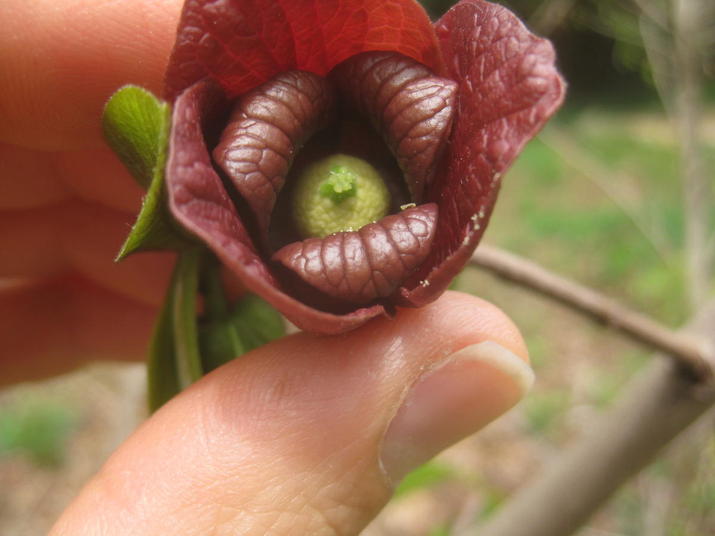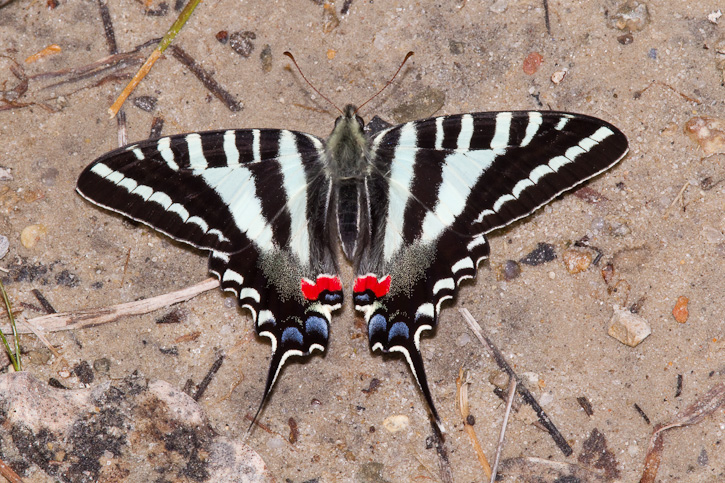The Zebra Swallowtail (Eurytides Marcellus) and the Common Pawpaw (Asimina triloba) are both evolutionary misfits. A cursory glance at both may fail to yield a connection but a closer look shows a complex relationship between the butterfly and the fruit tree that gives us insight into the evolutionary path of both.
Let us first examine the pawpaw tree.

The pawpaw is the largest tree fruit native to North America. Because we now call something that is quintessentially American as “American as apple pie” and we count Johnny Appleseed as a national folk hero, it is easy to forget that apple trees, as well as pears and peaches, are actually Eurasian in origin and were brought to North America by settlers. Not so the pawpaw tree. It was already firmly rooted in the south eastern portion of the country and as far north as Michigan and southern Ontario. The trees aren’t particularly large, averaging about 30 feet in height, and the trunks are slender. Pawpaw trees are typically found in clusters in the understory of deciduous forests.
The blossoms of the pawpaw tree emerge as light green then mature into a dark red colored flower that produces a strong and unpleasant odor. Pawpaw blossoms are protogynous dichogamy, which means they are incapable of self-pollinating because the flower’s stigmas are designed to receive pollen before pollen is released from the flower’s own anthers.
The fruit of the pawpaw tree grows in clusters and is oblong in shape. Pawpaws are greenish-yellow, ripening to a darker shade. The soft, fleshy pulp is yellow and tastes a bit like pineapple, mango, or banana. Pawpaw fruit is often used in puddings, pies, and ice cream, but it can be eaten fresh. The thin skin of the pawpaw fruit means it bruises easily. Additionally, the fruit is climacteric, meaning it continues to ripen after it has be picked. The fruit is so delicate and has such a short shelf life that it is difficult to sell it commercially.
The pawpaw tree is a member of the Annonaceae family which also includes the tropical custard apple and the cherimoya. All of its cousins are found in tropical climates; the pawpaw is the only member of this genus that grown in temperate climate of North America.
And now a bit about the zebra swallowtail.

A variety of the kite swallowtail family, the zebra swallowtail, the zebra swallowtail’s tail is longer and its wings are more triangular than its cousins. Its wingspan averages two and a half to four inches across. The black and whitish-green stripes give it its name. Additionally, the butterfly has a bright red spot and two blue dots on its wings.
Zebra swallowtails choose to lay eggs only on the emerging terminal leaves of the pawpaw tree. Aiding in the process is the Asimina webworm moth (Omphalocera munroei) that dines on the older pawpaw leaves, thus promoting new leaf growth. The zebra swallowtail deposits one egg per leave so as to keep the newly-hatched caterpillars separated…they tend to eat each other. The young pawpaw leaves that the swallowtail so likes are high in acetogenius, a substance that makes them unpleasant-tasting for rabbits, deer, and other leave eaters. As the caterpillars hatch and feed on the acetongenius-rich leaves, they are able to synthesize the essential oils, or terpenes, from the pawpaw leaves, so when they encounter a potential predator, the caterpillar thrusts out its osmeterium and releases a terrible odor.
The caterpillars stick around the pawpaw tree and when the time comes, they form their cocoons under a pawpaw leaf. The mature zebra swallowtail butterflies typically don’t venture too far from a pawpaw tree.
The relationship between the pawpaw tree and the zebra swallowtail is one-sided. The butterfly does not help pollinate the pawpaw blossoms – that task falls to carrion beetles and flies who are attracted to the putrid fragrance. And the swallowtail does not aid in seed dispersal, either, and this in an area in which the pawpaw could use some assistance. The tree evolved and adapted to life in North America while its original seed dispersing agent did not. The seeds of the pawpaw fruit are too large to be digested by most North American browsers and the ones who can consume them, such as deer, avoid the fruit due to its unpalatable chemical defenses. Biologists believe that the pawpaw tree may have co-evolved in North America with some of the region’s now-extinct megafauna, such as the American camel, the giant ground sloth, or the mastodon. With the extinction of these seed dispersing agents, the pawpaw was at risk of dying out too, and taking the zebra swallowtail with it.
Fortunately, the pawpaw had one more evolutionary card to play. Rather than relying on others to spread its seeds, the pawpaw adapted to propagate by sending out root suckers. Because of this, it is common to find groves of pawpaw trees, all of the same genotype.
Both the pawpaw tree and the zebra swallowtail are anachronistic – ecologically, they don’t belong where they are found. A study of their relationship shows us just how complex and interwoven their evolutionary path has been. While they have evolved together, it is clear that other members of their web of co-dependency did not. Despite this, both species are thriving in the habitat they now call home.
Sources
Barlow, Connie. The Ghosts of Evolution: Nonsensical Fruit, Missing Partners, and Other Ecological Anachronisms. New York, Basic Books, 2002.
Hormaza, Jose I. “The Pawpaw, a Forgotten North American Fruit Tree.” The Arnold Arboretum, vol. 72, no. 1, 2014, pp. 13-23. www.arboretum.harvard.edu/wp-content/uploads/2014-72-1-the-pawpaw-a-forgotten-north-american-fruit-tree.pdf.
Seale, Laura. “Connections: The Pawpaw Tree and the Zebra Swallowtail Butterfly.” Edited by Devin Floyd, et al. Blue Ridge Discovery Center Blog, 3 Aug. 2011. blueridgediscoveryproject.blogspot.com/2011/08/connections-pawpaw-tree-and-zebra.html.
Marzolo, Gina. “Pawpaw.” Agricultural Marketing Resource Center, California State Polytechnic University, Jan. 2016, www.agmrc.org/commodities-products/fruits/pawpaw/.
